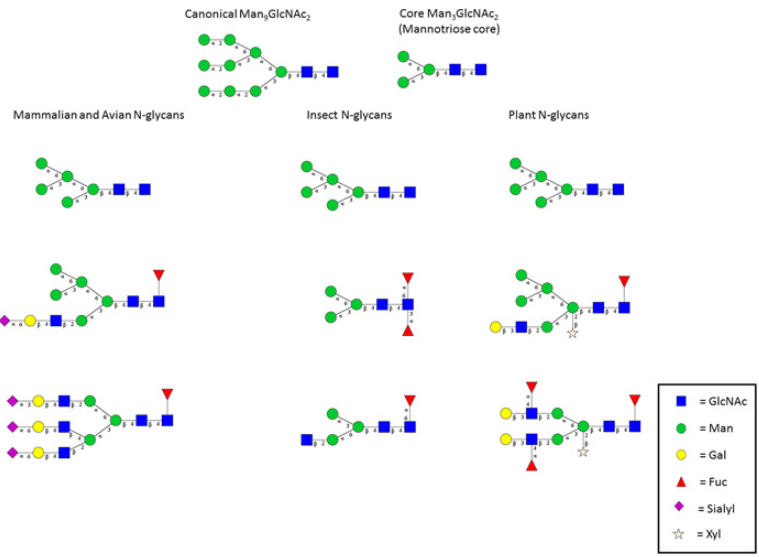N-Linked Glycoproteomics Sample Preparation
Glycosylation refers to the enzymatic process of attaching glycans to proteins, lipids, or other organic molecules, and is the most common post-translational modification (PTM) of proteins. There are two most common forms of glycosylation, including N-and O-linked glycosylation. To determine the functions of glycoproteins in normal and pathologic cellular functions, it is necessary to perform N- and O-glycosylation analysis. Currently, there is an increasing application of mass spectrometry on glycoprotein for a series of viruses, such as HIV and influenza. Since glycosylation is macro- and micro-heterogeneous and changes the dissociation behavior of glycopeptides, specific sample preparation and tailored bioinformatic data analysis methods are required. Based on a team of professional and experienced scientists, Creative Proteomics is capable of offering N-linked glycoproteomics sample preparation services for mass spectrometric data acquisition. We are committed to providing high-quality service to greatly accelerate our customers' project progress and success.
 Fig1. Major N-glycans produced in cellular systems used in viral production. (Cipollo, J. F., & Parsons, L. M., 2020)
Fig1. Major N-glycans produced in cellular systems used in viral production. (Cipollo, J. F., & Parsons, L. M., 2020)
The development of biochemical methods for the isolation and analysis of viral glycoproteins and glycans
The development of new biochemical methods has promoted the isolation and analysis of viral glycoproteins and glycans. The use of plant lectins or serum from immunized animals and immunized patients contributes to the purification of viral envelope proteins and makes it possible to analyze glycans at the level of individual proteins. The introduction of chemical glycan release from the peptide or sequential enzymatic deglycation allows for a more accurate determination of the size and composition of the viral glycan and further facilitates characterization of N- and O-linked glycans of many viruses. Further, the introduction of reverse phase HPLC combined with proteases of defined specificity enabled the separation and analysis of larger glycopeptides. The subsequent introduction of enzymatic glycan release makes it available to analyze N-glycan on isolated glycopeptides and even insight into the microheterogeneity of site-specific glycan in different hosts. Notably, the analysis of glycoproteins and glycans has greatly benefited from the advancement of mass spectrometry-based methods, which were soon applied to the field of virology.
Service offering in Creative Proteomics
In order to achieve precise and confident N-Linked glycoproteomic analysis, including mapping of glycosylation sites and glycoforms, we offer N-Linked glycoproteomic sample preparation services for mass spectrometric data acquisition. Our services mainly include glycoprotein digestion with combinations of proteases and multi-step enrichment protocols prior to the LC-MS/MS detection. Notably, instead of using trypsin (the gold standard used in most proteomics studies), we offer a variety of proteases with different complementary specificities for sequential digestion. The method has the characteristic of high recognition confidence and is suitable for the field of glycoproteomics, offering nearly complete sequence coverage and multiple peptides for each glycosylation site. Based on our services, customers can obtain a glycopeptide of suitable size for subsequent LC-MS/MS analysis containing only one N-glycan sequon. Our services are particularly suitable for the identification of HIV-1 Env trimers, various coronavirus spike glycoproteins, and so on.
Benefits of our services
- Professional technical support
- Rapid and efficient service, allowing investigation of large sample cohorts
- Highly reproducible sample preparation
- Customized service to customer satisfaction
If you are interested in our services, please don't hesitate to contact us. We are glad to cooperate with you and witness your success!
How to order?

Reference
- Cipollo, J. F., & Parsons, L. M. (2020). “Glycomics and glycoproteomics of viruses: Mass spectrometry applications and insights toward structure–function relationships.” Mass Spectrometry Reviews, 39(4), 371-409.
* For research use only.

 Fig1. Major N-glycans produced in cellular systems used in viral production. (Cipollo, J. F., & Parsons, L. M., 2020)
Fig1. Major N-glycans produced in cellular systems used in viral production. (Cipollo, J. F., & Parsons, L. M., 2020) 